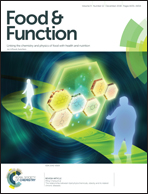Food matrix and processing modulate in vitro protein digestibility in soybeans
Abstract
Soybeans represent the largest source of plant proteins on the planet but their proteins are associated with low digestibility. Although several studies addressed the limiting factors affecting the rate and extent of soy protein digestion, the net effect of the food matrix, especially of an intact cell wall, has been poorly investigated so far. The purpose of the present study was to examine the relationship between the cell matrix and protein hydrolysis during simulated in vitro digestion of soybean particles of different sizes prepared from unheated and boiled cotyledons. In addition, intact cells were isolated from unheated and autoclaved cotyledons and then digested with and without lipase inhibitors to understand the impact of an intact cell wall and the presence of oil bodies on soybean protein digestibility. Protein digestibility was the highest in the particles prepared after boiling of previously milled cotyledons compared to particles of the same size obtained by milling previously cooked cotyledons as well as of uncooked cotyledons. Protein digestibility in isolated intact cells was lower than that of extracted proteins regardless of the thermal load applied whereas inhibition of pancreatic lipase reduces protein digestibility only slightly. The data indicated that the cell wall could contribute to limit protein digestion in soybean tissues; however, it is not an absolute barrier to pancreatic proteases. An accurate design of the milling and cooking process could be instrumental to modulate the digestion kinetics of soybean proteins.



 Please wait while we load your content...
Please wait while we load your content...